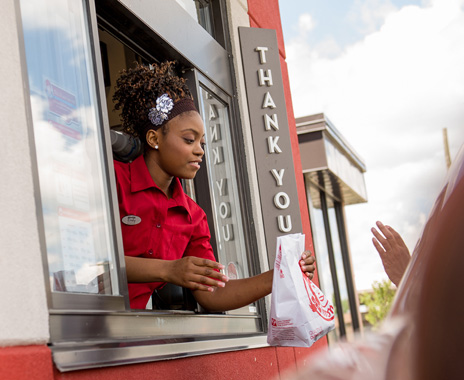The average American will spend over $1,200 on drive-thru food annually. The value of having a drive-thru has increased tremendously since the onset of the pandemic. The NPD Group Tuesday reported that drive-thru visits increased 26 percent in the April, May, and June quarter and represented 42 percent of all restaurant visits.
In July when more restaurants were reopened, drive-thru visits still increased 13 percent, the highest among the service modes of on-premises, carryout, and delivery, according to NPD’s daily tracking of U.S. consumers’ use of restaurants and other foodservice outlets.
Since the 1940s, drive-thrus continue to capitalize on convenience and quick ordering. Drive-thrus are likely to increase in popularity now that social distancing guidelines have come into play.
Quick-service restaurants, like most other businesses, have had to find ways to adapt to recent challenges. For instance, quick-service restaurants obtain sales primarily through two types of customers, the first being daily population customers, and the second being passerby customers. Passerby customers consist of people who happen to stop at a quick-service venue while on the way to their destination; passerby customers are typically not frequent customers at one specific restaurant.
READ MORE: THE RACE TO THE DRIVE THRU IS ON
The daily population consists of customers who live or work near a restaurant and frequent the restaurant multiple times a year. Since the COVID-19 pandemic hit the U.S., there has been a decrease in commuter traffic. While most offices have shut down and people are working from home, quick-serves are experiencing less traffic from those customers who would typically visit during a lunch break.
This decrease in commuter traffic has caused coffee shops such as Starbucks, Dunkin’, and Coffee Bean to experience a decline in sales. As people choose to stay home instead of going out, the decrease in overall traffic has caused a decline in the need for the convenience of drive-thrus. As people are staying home more and traveling less, some quick-serves are experiencing a drop in customers who would normally stop while commuting.
The socioeconomic results of COVID-19 have forced many major brands to innovate. We are seeing a sharp increase in brands investing in mobile ordering and delivery technology through cell phone apps. Additionally, quick-serves are adapting to optimize drive-thru lines as their inside dining rooms are closed. Some franchisee operators of national chains have made statements that they prefer the new model of drive-thru only as closing the dining room decreases expenses associated with paper products, soft drinks, cleaning, and maintenance.
Among the restaurants that encouraged customers to get their food to-go during the outbreak are Starbucks, Chick-fil-A, and Taco Bell. All of which utilized drive-thrus to limit large gatherings and keep customers safe.
There are two main differentiating factors of a quick-service restaurant versus a casual dining or sit-down restaurant. First is the short amount of time in which the customer receives their food after ordering. The second is the drive-thru. Drive-thrus have been critical to a quick-service restaurant’s success, not only during COVID-19 but overall.
Drive-thrus make the accessibility for customers significantly more convenient, and in turn, increase sales as much as 70 percent for some national chains. Panera Bread claims that adding a drive-thru window to its existing stores instantly generates more sales. As it relates to COVID-19, having a drive-thru allows a restaurant to remain open to customers as it limits the physical contact between employees and guests. Furthermore, the CDC identified restaurants with drive-thrus as essential retailers, thus permitting them to remain open during the pandemic.
As most restaurants without drive-thrus have shut down, the only option other than cooking at home is to stop at a local quick-serves and pick up food through the window. Brands equipped with drive-thru’s have fared significantly better than sit-down restaurants during the COVID-19 pandemic. Drive-thru access is ideal for contactless ordering. Furthermore, restaurants are available on most major food delivery platforms. Mobile apps allow customers to order meals with minimal interaction. The changes brought on by COVID-19 have resulted in less competition from full-service sit-down restaurants which has benefited quick service restaurants.
All in all, drive-thrus have been the top contender for distributing food to customers during the COVID-19 pandemic. On average, 50 million Americans eat fast food every day, generating $570 billion in global revenue, with an annual growth of approximately 2.5 percent. Quick-service restaurant assets have a clear advantage during COVID-19, making them a sound investment for commercial real estate investors.
Connor Olandt is a retail investment expert specializing in representing clients in the disposition and acquisition of net-leased properties across the U.S., with a specific emphasis on restaurant properties. Connor and his team have successfully represented both institutional and private clients giving unparalleled service and market-leading advisory. Connor’s passion for real estate, experience, and extensive knowledge of the market help him provide the most value for his clients. Connor’s dedication and strong work ethic have proven to exceed client expectations in obtaining the highest value for their investments.
Jon Prater is a retail investment expert specializing in representing clients with the disposition and acquisition of single tenant net leased properties across the United States, with a specific emphasis on quick-service restaurants. Jon and his team have successfully represented both institutional and private clients giving unparalleled service and market-leading advisory. Jon’s passion for real estate, experience, and extensive knowledge of the market helps him provide the utmost value for his clients. Jon’s commitment to building long-lasting client relationships through dedication and a strong work ethic have proven to exceed client expectations in obtaining the highest value for their properties.













